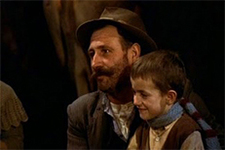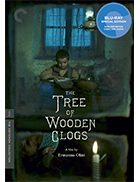The Tree of Wooden Clogs (L’Albero degli zoccoli)
|  Ermanno Olmi’s The Tree of Wooden Clogs (L’Albero degli zoccoli) is a rather extraordinary film. Based largely on Olmi’s recollections of stories told to him by his grandmother about her experience growing up in a poor farming community at the end of the 19th century, it is a true descendent of Italian neorealism, echoing with particular power and clarity the words of Cesare Zavattini, a screenwriter and one of neorealism’s first and most articulate proponents, from a 1952 interview that was published in English as “Some Ideas on the Cinema”: “the question today is, instead of turning imaginary situations into ‘reality’ and trying to make them look ‘true,’ to make things as they are, almost by themselves, create their own special significance. Life is not what is invented in ‘stories’; life is another matter. To understand it involves a minute, unrelenting, and patient search.” The Tree of Wooden Clogs is very much a minute, unrelenting, and patient search through a way of life that, by the time the film was made in the late 1970s, had not only disappeared in practice, but was in danger of disappearing from the collective cultural memory. Thus, the film is not only a drama about a group of characters and their various struggles over a calendar year, but also a kind of historical recreation of the material practices and lived experiences of the people of a bygone era that were in danger of being lost forever. It is a quiet, beautiful, intensely observed film, one that fulfills Zavattini’s admonition that the cinema must “tell reality as if it were a story.” Zavattini, of course, insisted that the practice of neorealist filmmaking be focused on the present (“Today, today, today,” he wrote), but part of what makes The Tree of Wooden Clogs so perpetually moving is that the fundamental social, personal, and economic issues of the world it depicts, while vitally specific to that world, are still with us today. Poverty, familial struggle, exploitation, class disparity, and the human need to grapple with and tame the natural world have not been diluted by the multiple generations that have come and gone since the 19th century. The Tree of Wooden Clogs is arguably one of the purest instances of neorealism since Luchino Viscoti’s La terra trema (1948), which was shot entirely in a Sicilian fishing village using nonprofessional locals as actors and was originally intended to be part of a never-completed trilogy about fishing, mining, and agriculture in postwar Sicily. The Tree of Wooden Clogs is very much in that vein, focusing as it does almost entirely on the agricultural life and its attendant struggles. The story takes place in and around a large farmhouse known as a cascina in the Province of Bergamo in the Lombardy region of northern Italy (to maintain authenticity, all of the characters, who are played by actual residents of the area, speak in the Bergamasque dialect). The farm itself is owned by a wealthy landlord, who allows four families to live in the house, which is a large, almost industrial-looking concrete structure built around a courtyard that combines both living spaces and quarters for the animals. In exchange, the farmers and their families work the land, for which the landlord is paid two-thirds of the crops. The farmers own nothing except the small percentage of the yield they are allowed to keep to both feed themselves and sell. Most of the animals, the tools, and, of course, the land itself belong the landlord. Olmi’s screenplay is loosely structured around the four seasons, as we observe the various characters going about their lives, dealing with struggles both large and small, finding pleasure and pain, hope and defeat, life and loss. The first characters to whom we are introduced is Batistì (Luigi Ornaghi) and his wife Batistina (Francesca Moriggi), whose five-year-old son Minec (Omar Brignoli) is to begin schooling at the Catholic Church four miles away. Batistì worries about the long walk the boy will have to endure each day, not to mention the social discomfort he feels about his son getting a formal education that he does not have. That trek back and forth becomes the source of the film’s title, as one of the boy’s wooden clogs comes apart on the walk home one day, forcing Batistì to secretly cut down a poplar tree to make a new one (the equivalent of stealing from the landlord). Other stories involve a recent widow who does laundry to provide for her six children, two of whom she considers sending to the Catholic orphanage just to ensure their survival, and wily old Grandpa Anselmo (Giuseppe Brignoli) plotting to get an early tomato harvest. A young couple meets and gets married, another family struggles with the threat of their cow dying, while a revolution brews in the vicinity, an abstraction to these peasants who are just trying to make it through to the next season. Despite being a historical recreation, The Tree of Wooden Clogs feels in many respects like a documentary, so it should be of no surprise that writer/director Ermanno Olmi began his film career in the documentary tradition before shifting to narrative feature films in the neorealist mold like Il posto (1961) and I Fidanzati (1963). The Tree of Wooden Clogs remains one of his best known and most loved films, partially because it was the unanimous recipient of the Palm d’Or at the 1978 Cannes Film Festival. Its accolades are testament to its experiential power, which derives from both its attentive sense of detail and its broader sense of humanist compassion. There are multiple points at which the film could slip into mawkish sentimentality or regressive romanticizing of the nobility of poverty, but it never does (Olmi, who acted as his own cinematography and editor, manages to make the peasant world both impossibly beautiful, with its mist-shrouded fields and hazy skies, and discomfortingly grimy and cold). Olmi could perhaps be faulted for not being more political, but one could also argue that the film benefits from avoiding the didacticism that often accompanies such a position. The Tree of Wooden Clogs works primarily because it is direct and honest. You don’t need to have experienced its world firsthand to grasp the transparency with which Olmi depicts it, full as it is with simple pleasures, complex emotions, and unadorned heartbreak. In its own rough way, it is a thing of real beauty.
Copyright © 2017 James Kendrick Thoughts? E-mail James Kendrick All images copyright © The Criterion Collection | |||||||||||||||||||||||||||||||
Overall Rating: 


 (3.5)
(3.5)


